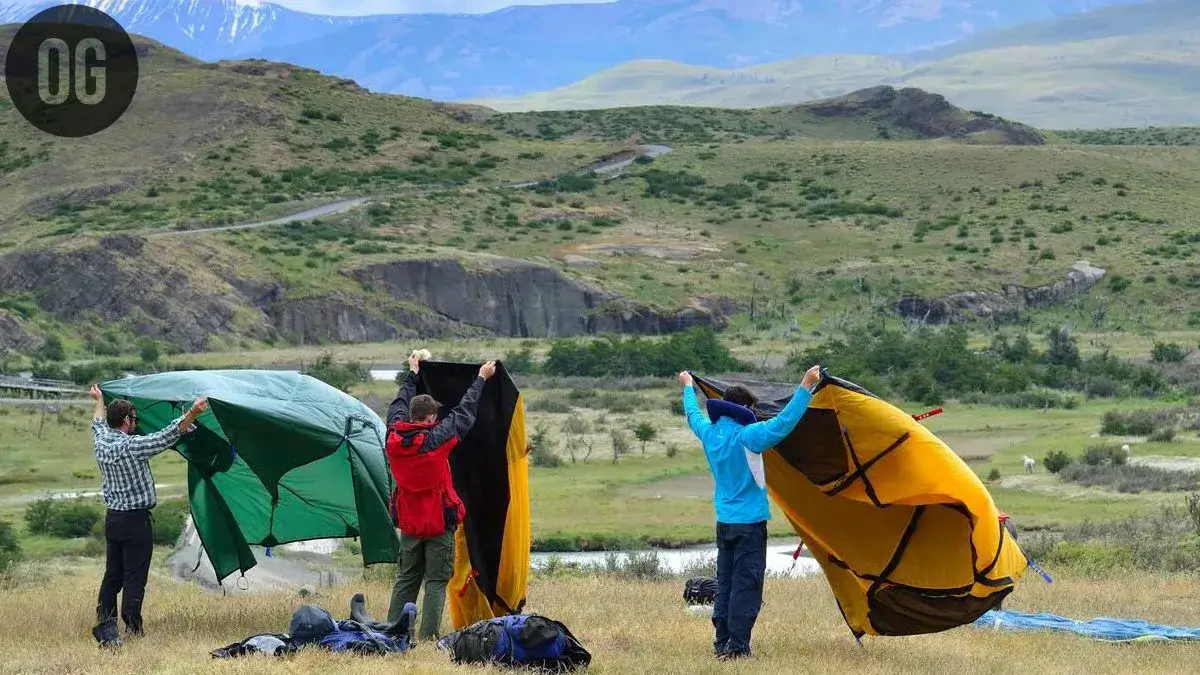7 Winter Camping Hacks To Stay Warm With 7 Editor’s Special Secret Tips
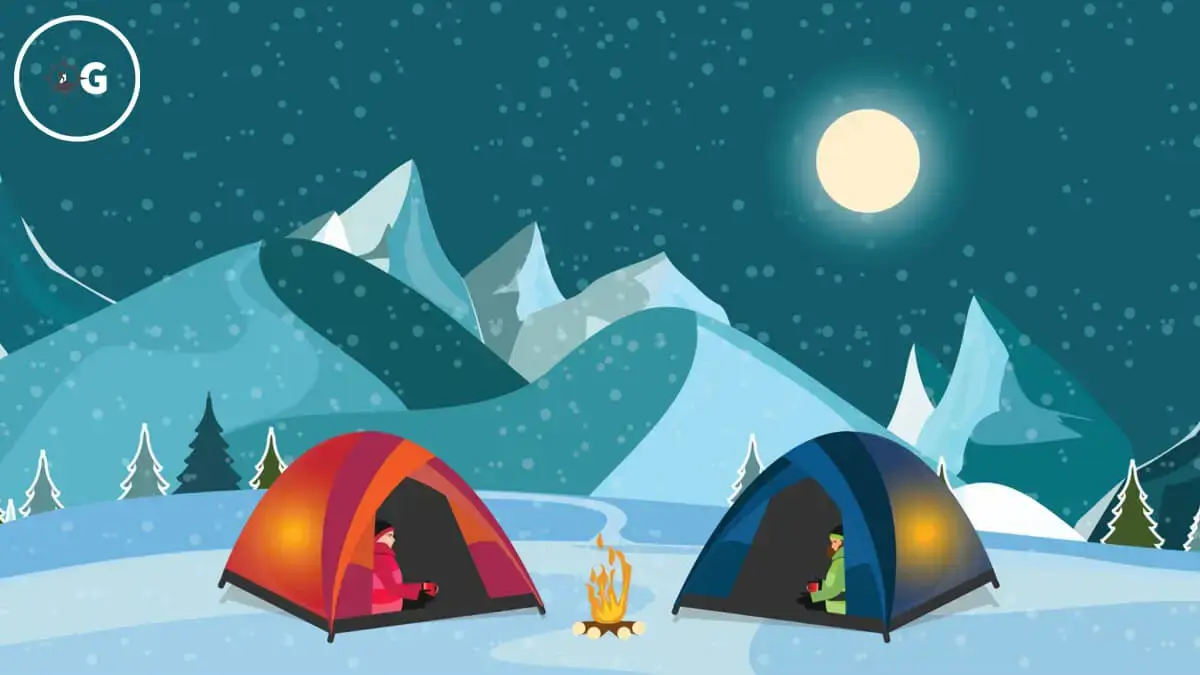
Embarking on winter camping, a thrilling yet challenging endeavor, places the quest for warmth at the forefront. Explore these Winter Camping Hacks To Stay Warm and conquer the elements.
Staying warm is not just a comfort; it’s a crucial factor for safeguarding health and well-being amidst plummeting temperatures.
However, the challenges are real – biting winds, subzero temperatures, and the constant battle against hypothermia and frostbite.
Table of Contents
This comprehensive guide delves into the art of staying warm in cold weather tents, offering a curated selection of effective strategies.
Explore Winter Camping Hacks To Stay Warm, as this article provides insights into advanced gear, tent setup, insulation methods, heat sources, and mental resilience. Gain the know-how to embrace the chill while staying cozy and secure.
Understanding Cold Weather Camping
Camping in cold weather demands a comprehensive understanding of the factors that contribute to discomfort and the associated risks.
A combination of environmental elements and inadequate preparation can turn a promising adventure into a hazardous ordeal.
A. Factors Contributing to Cold Weather Discomfort
Temperature and Wind Chill: The interaction between the ambient temperature and wind speed dramatically affects perceived cold.
Wind chill accelerates heat loss from the body, leading to rapid cooling and discomfort, potentially culminating in hypothermia.
Humidity and Moisture: High humidity and moisture accumulation amplify cold’s effects. Moisture infiltrating clothing reduces insulation capacity, causing chill. Moreover, damp conditions increase the risk of frostbite as freezing temperatures impact wet skin and tissues.
Insulation and Heat Loss: Inadequate insulation, whether through improper clothing or bedding, results in heat loss.
Poorly insulated tents or sleeping setups allow cold to seep in, making it harder for the body to maintain warmth.
B. Risks Associated with Cold Exposure
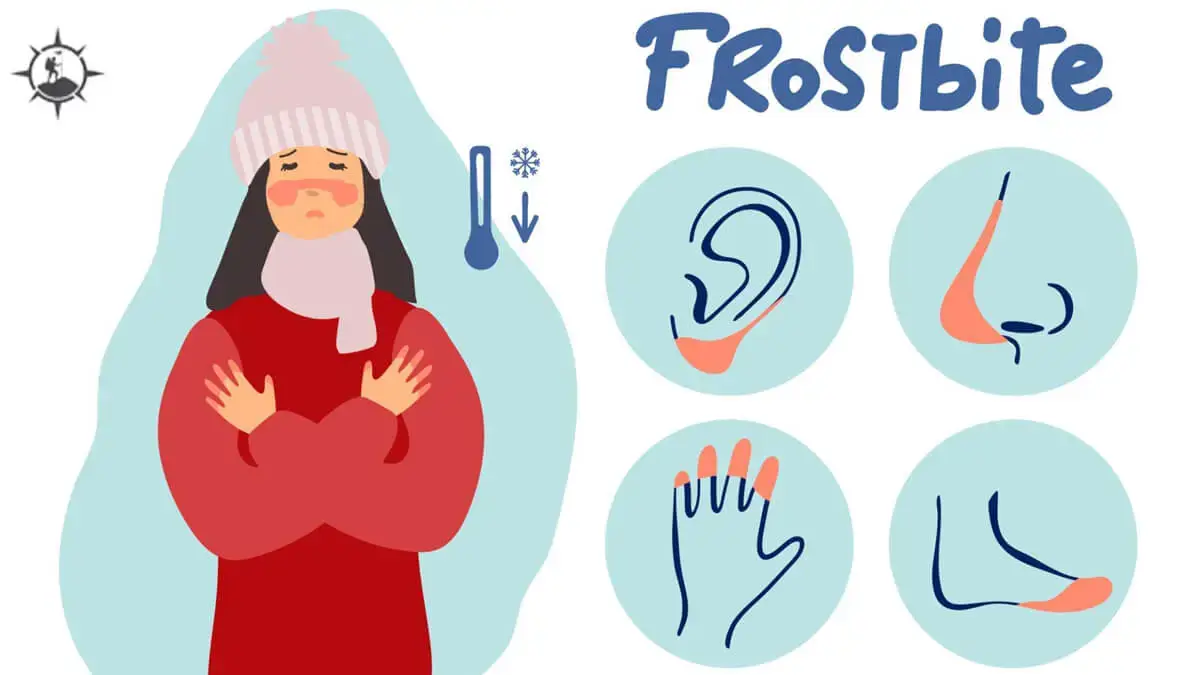
Hypothermia and Frostbite: Prolonged cold exposure leads to hypothermia, characterized by a dangerously low core body temperature.
Symptoms progress from shivering and confusion to life-threatening complications. Frostbite occurs when extremities freeze, causing tissue damage and potential amputation.
Health Implications of Inadequate Preparation: Camping without appropriate gear, clothing, and knowledge heightens health risks.
Inadequate preparation increases susceptibility to cold-related illnesses, like respiratory infections, exacerbation of cardiovascular conditions, and compromised immune function.
Proactive measures, including proper layering, insulated gear, suitable tents, and awareness of weather forecasts, are essential for countering these challenges.
Understanding the interplay of temperature, humidity, and insulation, coupled with recognition of the potential health risks, empowers cold weather campers to make informed decisions, ensuring their safety and enhancing their enjoyment of outdoor experiences.
Pre-Trip Preparations for Cold Weather Camping

Achieving a successful winter camping expedition relies on meticulous pre-trip arrangements. Incorporating Winter Camping Hacks To Stay Warm, these encompass optimal gear choices, strategic timing, and thorough planning—essential for ensuring warmth and safety in the brisk wilderness.
A. Gear Selection and Planning
Choosing Appropriate Tents for Cold Weather: Opt for 4-season or winter-specific tents designed to withstand harsh conditions.
These tents feature robust materials, sturdy poles, and snow skirts to guard against wind and snow infiltration, providing essential protection from the elements.
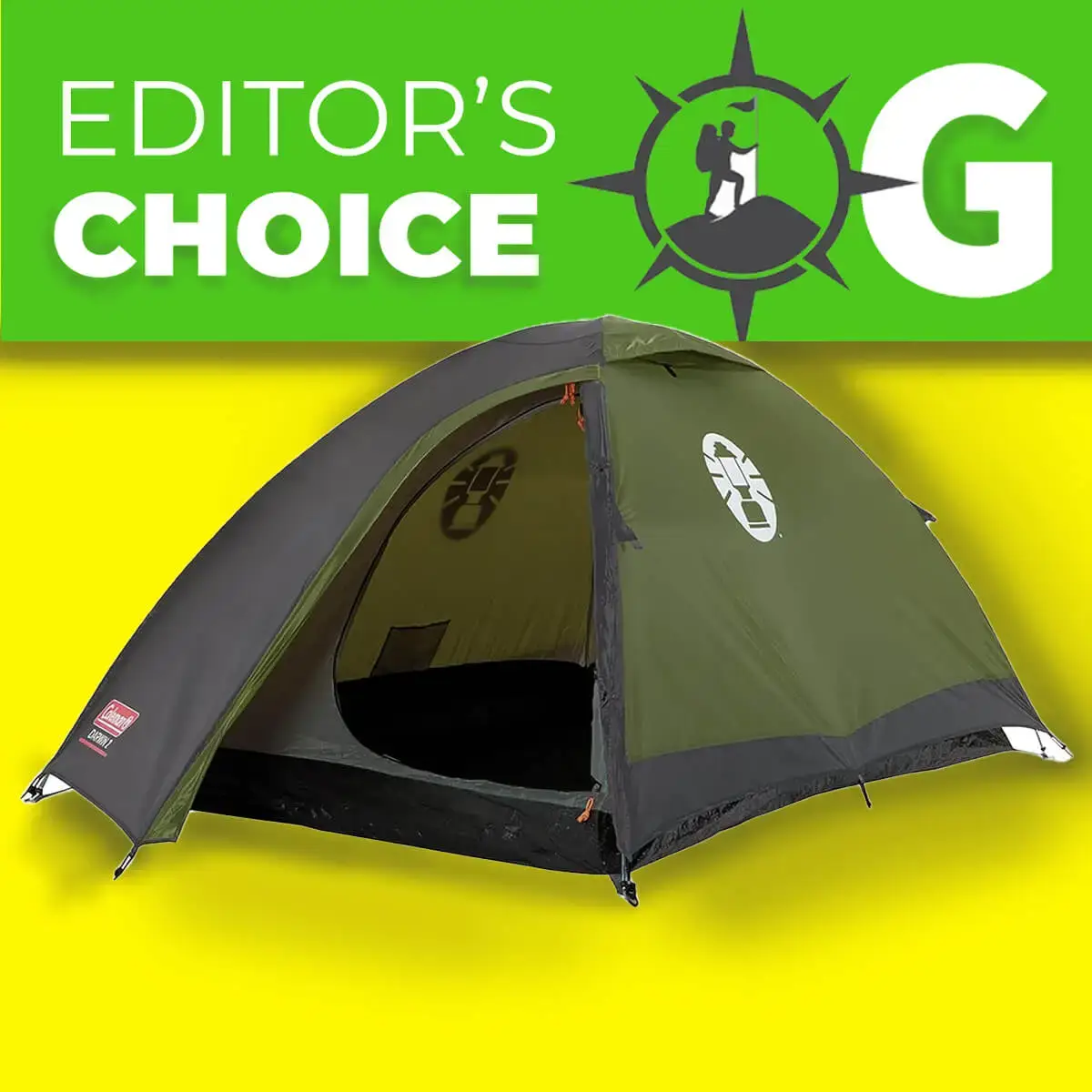
Coleman Darwin Camping Tent
The Coleman camping tent is our editor’s recommended all season best camping and backpacking tent. The Coleman Polyester Darwin 3+ Camping Tent emerges as a brilliant camping solution, particularly tailored for high-altitude escapades in the Himalayas.
Its streamlined quick-pitch dome design, accompanied by a robust ring and pin pole attachment, promises a hassle-free setup. Featuring a capacious porch furnished with PVC windows, curtains, and an extra waterproof porch for gear storage, the tent prioritizes convenience. Crafted from top-notch polyester campingmaterials, incorporating a breathable inner lining and durable outer fabric, it emanates longevity. Amplified by WeatherTec waterproof technology and UV guard sun protection, the tent guarantees unwavering safety. The incorporation of lightweight fiberglass poles reinforces stability against demanding winds and storms. Moreover, the tent includes a complimentary campers tool and access to the Coleman Club, rendering it an extraordinary choice for altitude-seekers who covet both opulence and ruggedness, including invaluable Winter Camping Hacks To Stay Warm.
Related: 7 Best Tents For Camping And Backpacking
Quality Sleeping Bags and Sleeping Pads: Invest in sleeping bags with lower temperature ratings than anticipated, ensuring adequate warmth during the coldest nights.
Pair them with insulated sleeping pads to create a barrier against cold ground, preventing heat loss from your body.
Trajectory Sleeping Bag

Trajectory Sleeping Bag is one of the best sleeping bag for winter camping. The Trajectory sleeping bag offers comfort and reliability for outdoor adventures. With a -5°C rating, it suits those sensitive to cold and damp conditions. Its durable, water-resistant, breathable material accommodates various sizes while keeping you cozy. The adjustable hood adds warmth.
WELLAX FlexFoam Sleeping Pad

It is one of the best best sleeping pad for camping in India. Tested in various terrains, this 3-inch inflatable pad stands out for its optimal balance of weight, warmth, and comfort. Its plush design provides ample support and warmth, making it ideal for active sleepers and cold weather.
The innovative foam frame merges the best of foam mattresses and air pads, ensuring unrivaled comfort. Crafted from durable materials like 20D Rip-stop Nylon and TPU Layer, it’s waterproof and tear-resistant, offering a remarkable warmth-to-weight ratio. With a 9.6 R-Value, it’s perfect for chilly nights. The pad’s dimensions (77″ x 28″ x 3″) and portability (7lbs) add to its appeal. Invest in the WELLAX Sleeping Pad for a luxurious camping experience that rejuvenates your muscles and keeps you warm after an adventurous day on the trails.
Clothing and Layering Techniques: Employ a strategic clothing approach, layering to trap warm air close to your body.
Start with moisture-wicking base layers to keep sweat away, add insulating mid-layers for warmth, and finish with a waterproof and windproof outer shell to repel external elements.
B. Weather Forecasting and Trip Timing
Monitoring Weather Conditions and Forecasts: Stay informed about upcoming weather patterns by checking reliable forecasts through apps, websites, or local ranger stations.
Be vigilant about temperature trends, wind speed, and precipitation, adjusting your plans accordingly.
Planning Trips During Milder Weather Windows: Whenever possible, plan your camping trips during milder periods within the cold season.
This can mitigate extreme temperature fluctuations and reduce the risk of encountering severe weather events.
Flexibility in Adjusting Plans Based on Real-Time Conditions: Nature is unpredictable. Maintain flexibility in your itinerary to adapt to changing weather conditions.
If an unexpected cold front or storm moves in, be prepared to alter your route, campsite, or even postpone your trip for safety reasons.
Site Selection and Tent Setup for Cold Weather Camping

Winter Camping Hacks To Stay Warm encompass essential factors like site selection and tent setup. These critical elements profoundly impact your comfort and safety during cold weather camping.
Skillful site choice and careful tent arrangement are key to maximizing warmth and coziness in the icy outdoors.
A. Choosing a Suitable Campsite
Elevation and Exposure Considerations: Opt for sites that strike a balance between elevation and exposure.
Lower elevations are less prone to frigid winds, while avoiding overly exposed ridges and summits helps shield your camp from harsh gusts that can sap warmth.
Natural Windbreaks and Sheltered Areas: Utilize natural features like dense vegetation, large rocks, or terrain contours to create natural windbreaks around your campsite.
These structures help mitigate wind chill, providing a more temperate environment for your tent.
Avoiding Low-Lying or High-Wind Areas: Steer clear of valley bottoms and depressions where cold air tends to accumulate.
Similarly, avoid setting up camp in areas prone to strong, consistent winds that can penetrate your tent and compromise its insulation.
B. Tent Setup for Optimal Warmth
Directional Placement for Wind Protection: Position your tent entrance away from prevailing winds.
This prevents cold drafts from sweeping into your shelter and maintains a more stable interior temperature. Use natural barriers or additional tarps to further shield your tent from wind.
Ground Insulation and Protection from Cold: Lay down a layer of insulating material, such as closed-cell foam or an insulated footprint, beneath your tent.
This prevents cold ground from sapping your body heat, enhancing your overall warmth and comfort.
Proper Ventilation to Manage Condensation: While sealing your tent is essential for warmth, adequate ventilation is equally crucial to prevent condensation buildup.
Open vents slightly to allow moisture to escape, reducing the risk of dampness that can compromise insulation and increase cold.
Insulation and Layering Techniques for Cold Weather Camping
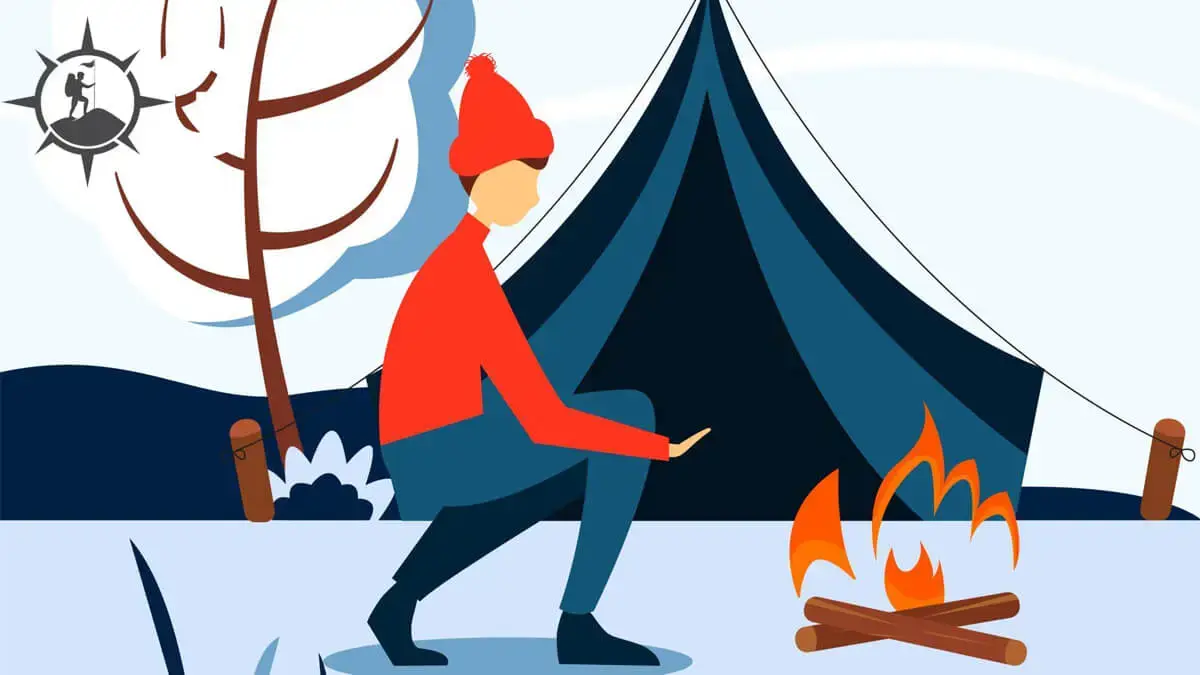
To conquer the chill during cold weather camping, Winter Camping Hacks To Stay Warm advise mastering insulation and layering methods.
Smart clothing choices and adept sleeping system techniques transform freezing nights into cozy, restful outdoor experiences.
A. Clothing Layering Principles
Base Layer, Insulation Layer, and Outer Shell: Adhere to the three-layer principle. Start with a moisture-wicking base layer that keeps sweat away from your skin.
Add an insulating layer, such as fleece or down, to trap body heat. Finish with an outer shell that’s windproof and waterproof to shield against external elements.
Moisture-Wicking Fabrics and Breathability: Choose clothing made from moisture-wicking materials like merino wool or synthetic fabrics.
These materials pull sweat away from your body, preventing moisture buildup that can lead to chilling. Ensure your layers are breathable to allow excess heat to escape.
Adjusting Layers Based on Activity and Temperature: Be prepared to adjust your layers as you become more active or the temperature changes.
Start with more layers when stationary and remove as needed to prevent overheating and sweating, which can lead to dampness and discomfort.
B. Insulating the Sleeping System
Utilizing Sleeping Bag Liners and Bivy Sacks: Sleeping bag liners add an extra layer of insulation and help keep your sleeping bag clean.
Bivy sacks provide an additional barrier against cold and moisture, boosting warmth and protecting your sleeping bag from damp ground.

JITTY Sleeping Bag Liner
Its breathable fabric stays soft and cozy while preventing stickiness in hot weather. With a spacious size (83″ x 45″) and smart design, it’s easy to enter, exit, and stretch. The 33.5″ opening and foot zipper enhance convenience and separation. Weighing just 0.83lb, it’s light and foldable (7.8″x7.8″x2.3″), making it perfect for backpacking. This liner ensures cleanliness in hotels, hostels, and extends the life of your sleeping bag. Follow simple washing instructions for longevity.

Esky Bivy Sacks
A vital emergency tool for disaster or danger, serving as blanket, ground cover, beacon, and more. Durable Mylar shell ensures warmth, comfort, and protection in extreme conditions. Reflective surface aids visibility. Compact storage, bonus whistle, and precise compass enhance safety.
Combining Sleeping Bags for Added Warmth: When facing exceptionally low temperatures, consider using two sleeping bags together.
Place a lighter bag inside a warmer one for increased insulation. Make sure the inner bag is slightly roomier to prevent compressing insulation and reducing its effectiveness.
Choosing the Right Sleeping Pad for Insulation and Comfort: Select a sleeping pad with adequate insulation to prevent cold air from seeping through the ground.
Foam pads, insulated air mattresses, or inflatable pads with high R-values offer effective insulation. Balance warmth with comfort to ensure a good night’s sleep.
Campfire and Heat Sources for Cold Weather Camping

Navigating the cold temperatures of winter camping demands effective heat sources, a key factor in your comfort and well-being.
Embracing Winter Camping Hacks To Stay Warm, skillful campfire management and alternative heating methods not only provide warmth but also nourishment and a bonding atmosphere, enriching the camping journey.
Campfire Considerations:
Safety and Regulations: Before starting a campfire, familiarize yourself with local regulations and restrictions.
Respect fire bans and designated fire areas to prevent wildfires and preserve the environment.
Campfire Construction: Build a campfire pit using rocks or a fire pan to contain the flames.
Construct a teepee or log cabin arrangement with dry wood and kindling to ensure a steady, controlled burn.
Fuel Selection: Choose dry, seasoned firewood to produce efficient and consistent heat.
Hardwoods like oak or maple burn longer and hotter, while softwoods like pine ignite quickly and provide a lively flame.
Alternative Heat Sources:
Portable Camping Stoves and Heaters: Compact camping stoves, fueled by propane or liquid fuel, offer reliable heat for cooking and warmth.
Portable heaters, such as catalytic or radiant propane heaters, provide controlled warmth within your tent or outdoor space.
Hot Water Bottles and Warmers: Fill a heat-resistant water bottle with warm water and place it inside your sleeping bag to generate cozy warmth.
Chemical hand warmers or reusable gel packs can also be placed in pockets or boots for added comfort.
Heating Rocks for Radiating Warmth: Heat rocks in a campfire and carefully place them in a metal container, then move the container into your tent. The rocks will emit radiant heat, creating a cozy atmosphere inside the tent.
Health and Environmental Considerations:
Ventilation: When using alternative heat sources inside tents or shelters, ensure proper ventilation to prevent carbon monoxide buildup. Keep tent doors or windows slightly open to allow fresh air circulation.
Leave No Trace: Practice responsible fire management and clean up your campfire area before departing. Extinguish fires completely and pack out any remaining ashes or debris.
Respect Nature: Use dead and downed wood for campfires to minimize environmental impact. Avoid damaging live trees or vegetation for fuel.
Nutrition and Hydration for Cold Weather Camping

Sustaining your body’s warmth and vitality during cold weather camping hinges on proper nutrition and hydration.
Incorporating Winter Camping Hacks To Stay Warm, intentional food selections and hydration routines empower you to better combat the cold, ensuring a secure and cozy outdoor adventure.
A. Importance of Proper Nutrition
High-Energy Foods for Maintaining Body Heat: Consume nutrient-dense, high-energy foods that provide sustained fuel.
Complex carbohydrates like whole grains, nuts, and dried fruits offer a slow release of energy, helping to stoke your internal furnace and maintain body heat.
Warm Beverages and Soups for Internal Warmth: Hot drinks like herbal teas, cocoa, or warm broths serve a dual purpose – they hydrate your body while providing internal warmth.
The act of drinking warm liquids can also help raise your core temperature, combating the cold from the inside out.
B. Hydration Strategies
Dehydration’s Impact on Heat Retention: Dehydration compromises your body’s ability to regulate temperature. Even in cold weather, you lose moisture through respiration, sweat, and urination.
Depleted hydration levels hinder your body’s capacity to generate heat, making you more susceptible to cold-related discomfort.
Balancing Warm Drinks with Regular Water Intake: While warm beverages contribute to hydration, it’s essential to balance them with regular water intake. Cold air can be deceptively dry, causing moisture loss through respiration.
Sip water throughout the day to maintain optimal hydration levels and support your body’s heat-regulating mechanisms.
Additional Tips:
Nutrient Variety: Include a mix of protein, fats, and carbohydrates in your meals. Protein helps repair tissue and generate heat, while fats provide a concentrated source of energy.
Caloric Intake: In cold weather, your body burns more calories to stay warm. Consume slightly more calories than usual to compensate for this increased energy expenditure.
Portable Snacks: Pack easily accessible, high-energy snacks like trail mix, energy bars, and jerky to fuel yourself during activities.
Electrolyte Balance: Include electrolyte-rich foods or drinks to maintain proper electrolyte balance, which aids in hydration and overall bodily functions.
Activities to Generate Heat in Cold Weather Camping

Winter Camping Hacks To Stay Warm highlight that generating internal warmth involves more than clothing and insulation.
Engaging in intentional activities fosters camaraderie, internal heat, and enriches the cold weather camping journey with enjoyment and warmth.
A. Physical Activity’s Role in Staying Warm
Morning Exercises to Raise Body Temperature: Start your day with gentle exercises that elevate your heart rate and boost blood circulation.
Jumping jacks, squats, and light stretches help increase your body temperature, igniting your metabolic furnace for a warmer start to the day.
Engaging in Light Activities During the Day: Keep your body active by incorporating light, intermittent activities throughout the day.
Short hikes, nature walks, or simple stretches near your campsite stimulate blood flow and maintain a comfortable body temperature.
B. Social and Communal Activities
Group Games and Shared Warmth: Engage in group activities that not only provide entertainment but also generate body heat.
Playing interactive games like charades, card games, or storytelling around a campfire encourages movement and laughter, collectively raising the group’s internal temperature.
Body Heat Exchange in Close Proximity: When socializing, gather closely with fellow campers.
Sharing body heat through physical proximity creates a warm microenvironment, reducing individual heat loss and fostering a sense of togetherness.
Additional Tips:
Dress Appropriately: Wear lightweight, moisture-wicking layers during physical activities to prevent overheating and sweating excessively, which can lead to dampness and chill later on.
Stay Hydrated: Keep drinking water throughout the day to maintain optimal hydration levels, supporting your body’s ability to regulate temperature during activities.
Mindful Rest: While activity generates heat, also allow yourself moments of rest. Strategic breaks help prevent excessive sweating and overheating, maintaining a balanced body temperature.
Listen to Your Body: Pay attention to your body’s signals. If you start feeling too warm, remove a layer or slow down your activity to prevent excessive perspiration.
Mental and Psychological Warmth in Cold Weather Camping

Winter Camping Hacks To Stay Warm emphasize that braving the cold isn’t just about physical resilience; your mental outlook matters.
Fostering a positive mindset and utilizing stress reduction methods substantially influence your cold endurance, elevating the pleasure and fulfillment of your cold weather camping escapade.
Maintaining a Positive Mindset:
Mind Over Matter: The Psychological Impact on Cold Tolerance: The power of your mind can influence how you perceive and respond to cold. A positive attitude can help you endure discomfort more effectively.
Focus on the beauty of your surroundings, the thrill of the adventure, and the sense of accomplishment that comes from conquering challenging conditions.
Visualization and Mental Preparation: Before embarking on your cold weather camping trip, visualize yourself comfortably navigating the cold.
Mentally rehearsing positive scenarios can help alleviate anxiety and increase your mental readiness for the experience.
Stress Reduction Techniques to Manage Discomfort:
Breathing Exercises: Practicing deep, mindful breathing can help regulate your body’s stress response.
Slow, controlled breaths reduce anxiety, calm your nervous system, and encourage warmth by increasing blood circulation.
Meditation and Mindfulness: Engage in meditation or mindfulness techniques to focus your attention on the present moment.
These practices help redirect your mind away from discomfort, reducing stress and enhancing your ability to tolerate the cold.
Positive Self-Talk: Replace negative or self-doubting thoughts with affirmations and positive self-talk.
Remind yourself of your capabilities and strengths, boosting your confidence and resilience against cold-related challenges.
Additional Tips:
Stay Engaged: Keep your mind occupied with engaging activities like journaling, reading, or photography.
This mental engagement can divert your focus from the cold and elevate your overall mood.
Create Comfort: Personalize your campsite with cozy elements like warm blankets, soft lighting, and familiar items that evoke a sense of home.
Cultivating a comfortable environment can positively impact your mental state.
Social Connection: Interact with fellow campers, sharing stories, laughter, and camaraderie.
Meaningful social connections can provide emotional warmth and distraction from the cold.
Editor’s Essential Tips On Winter Camping Hacks To Stay Warm

1. Keeping Your Sleeping Gear Dry
During cold weather camping, it’s crucial to keep your sleeping gear dry for warmth and comfort.
Wet sleeping bags, mattresses, and blankets rapidly steal body heat, causing shivering or worse. To ensure dry and cozy sleeping conditions:
- Waterproof Tent: Ensure your tent is waterproof and seams are well-sealed to prevent leaks.
- Strategic Campsite: Choose a sheltered campsite to shield from wind and rain.
- Swift Drying: If gear gets wet, quickly dry it—hang items, use a laundromat with tumble dryers, or consider ending the trip.
2. Nighttime Attire
Having suitable nighttime clothing for various conditions, particularly during cold weather escapades, is essential.
While it might seem convenient to use the same daytime attire to lighten your pack, this approach is not advisable.
1. Don’t Wear Daytime Clothes at Night:
- Tempting for pack weight, but not recommended.
- Dampness from sweating doesn’t dry quickly.
2. Invest in Dry Cold-Weather Sleeping Clothes:
- Crucial for staying warm.
- Options: cozy long johns or moisture-wicking Merino wool base layer.
3. Breathable and Moisture-Wicking: Prevents clothes from becoming soaked if you sweat.
4. Enhanced Warmth with Night Clothes: Ensures comfort during chilly nights in nature.
3. Keep head and feet covered
- Prioritize covering head and feet.
- Invest in a warm, breathable hat to retain body heat.
- Hat while sleeping helps significantly on chilly nights.
- Add a woolen neck warmer for extra warmth.
- Opt for thick socks (wool or synthetic) that absorb sweat and insulate.
- Carry dedicated sleep socks to prevent nighttime coldness.
- Ensure all attire is dry before sleeping to avoid chilling effects.
4. Late Dinner Strategy
- Opt for a late dinner for effective warmth.
- Despite inconvenience, it offers significant benefits.
- A substantial meal rich in fat, protein, and carbs maintains core temperature.
- Eating a hearty, warm meal close to bedtime elevates core temperature before sleep.
- Body requires less effort to stay warm after a warm meal.
- Late dinner, combined with warm liquids before sleep, enhances comfort and minimizes nighttime cold discomfort.
5. Refrain from consuming caffeine and alcohol
- Wine or whiskey suits cozy cabins.
- In cold outdoors, avoid this mix for core temperature.
- Alcohol disrupts shivering, impairs self-warming.
- Alcohol expands skin vessels, deceptive warmth but chills core.
- Hot drinks ideal for hand warmth; coffee and tea dilate blood vessels like alcohol.
- Caffeine circulates cold blood, hindering warmth.
- Choose hot chocolate or decaf tea for warmth during winter camping.
6. Pre-Bed Exercise
- Light exercise before sleep boosts warmth.
- Enhances body temperature and comfort.
- Avoid excessive effort to prevent sweating.
- Engage in gentle activities: squats, lunges, light jogging.
- Prepares body for colder night temperatures.
- Improves sleep quality without consuming much time.
7. Best warming Gears
Here are some excellent thermal gear options that you can utilize to ensure your warmth and dryness during outdoor ventures.
Thus, we advise campers and hikers journeying to chilly or rainy environments for their outdoor escapades.
- Boot warmer
- Little Buddy mr. Heater
- Silk Sleeping Bag Liner
- Reusable Hand Warmers
- Merino Wool Ski Neck Gaiter
Our admiration extends to the practicality of our portable boot dryer. It operates swiftly and can even be powered using your vehicle.
Whether left overnight or placed in your boots upon morning awakening, particularly if you have an additional pair of shoes, this device brings unparalleled satisfaction as you slip your chilly feet into cozy boots.
Moreover, consider the utility of reusable hand warmers, not only for their environmental benefits in reducing single-use waste but also for their efficiency in minimizing your load.
These reusable hand warmers can be “recharged” by immersing them in boiling water, an amenity often accessible during cooking. This serves as an excellent substitute for carrying numerous disposable heat packs.
Conclusion
Embracing the allure of cold weather camping as winter sets in, Winter Camping Hacks To Stay Warm emphasize its distinctive allure. Equipped with suitable gear and strategic site selections, adventurers triumph over the chill.
Grouping around fires, partaking in communal games, and nurturing a positive outlook transform frosty surroundings into cherished memories of unity and accomplishment.
FAQs For Winter Camping Hacks To Stay Warm
What temperature is OK for camping?
A comfortable camping temperature is generally around 50-70°F (10-21°C) for spring/fall, 70°F (21°C) and above for summer, while winter camping requires appropriate gear for sub-freezing temperatures.
How can I keep my tent warm without a heater?
Candle lanterns, which are collapsible for easy storage, serve as efficient tent heaters. Hang them within the tent for a safe, lasting flame (9-12 hours). Additionally, stay warm by using insulated sleeping gear, layering clothing, placing a tent tarp, blocking drafts, eating high-energy foods, and staying active.
Can I use blankets for camping?
Yes, blankets can be used for camping, but they may not provide adequate insulation on their own. Combine blankets with proper sleeping bags and layers for better warmth and comfort.
Do tents absorb heat?
Tents do not generate or absorb heat significantly. They provide shelter from wind and elements, and their temperature depends on external conditions. Insulation and proper gear are essential for warmth.
What is the most comfortable thing to sleep on in a tent?
An inflatable sleeping pad or air mattress, combined with a quality sleeping bag, offers a comfortable sleeping setup in a tent. It provides cushioning and insulation from the ground.





